Church “vaults”
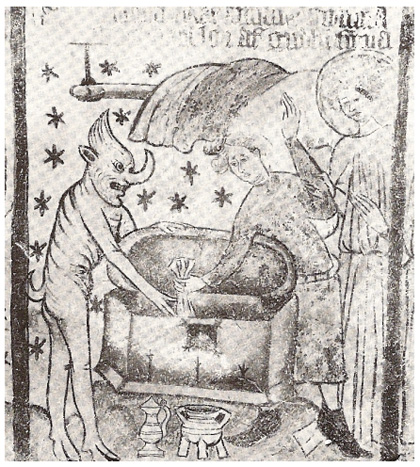 |
| Mural in Litslena church in Uppland. The devil tempting a person while an angel tries to prevent him from stealing from the church’s cash chest. 15th century. Photographer unknown. |
In the 15th to 16th centuries, sacristies were added on Swedish churches, on the north side of the building outside the sanctuary. They were built with sturdy stone walls and arched stone or brick ceilings, and the windows were protected by sturdy iron bars. Between the sanctuary and the sacristy was a heavy wooden door with wrought-iron hinges. It often had iron fittings or iron strips riveted on. The door was locked with a wooden block lock, a smithed tumbler lock, or in the 18th century, with a large wrought iron rim lock.
Sacristies are sacred rooms for storing liturgical vessels, vestments and other items, and served as a clothes closet for the priest. The rooms were largely fire and burglar-proof and served as vaults where the church funds were stored.
In some cases, the sacristy even served as the local parish bank, since it contained cash – often in leather pouches or boxes in a locked cabinet or an ironbound chest that could be locked with two or three sturdy padlocks.
Swedish banks
In the first half of the 16th century, King Gustav Vasa’s bailiffs collected large numbers of chalices and other items of silver from the monasteries and churches. These and all surplus from the mines, as well as other taxes, were stored with the King’s creditors and in his treasury (the Eskil stateroom). The treasury consisted of three vaults at the bottom of his royal residence, the Tre Kronor castle in Stockholm, near the central tower. Locked treasure chambers were also built in his other castles.
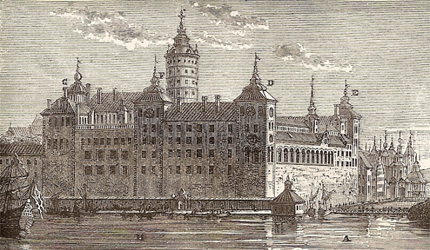 |
| The old Tre Kronor castle in Stockholm, with the central tower in the middle. |
Just over a century after Gustav Vasa’s death, Sweden’s national bank, the Riksbank (then called Rikets Ständer’s bank), was founded and placed under the leadership of the parliament. It opened its doors in 1668, making it the world’s oldest national bank. Yet it did have a precursor, the Stockholm Banco (also known as the Bank of Palmstruch), which was founded twelve years earlier. Today, the vaults of the Riksbank are blasted into the middle of the Brunkebergsåsen ridge. On December 31, 2005, the Riksbank’s financial assets were valued at $31.5 trillion.
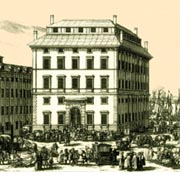 |
| Bank building on Järntorget Square in Old Stockholm, designed by Nicodemus Tessin the elder (1615–1681) in the style of an Italian palace. |
The first private banks were founded in the 1830s. By the end of the 19th century, the gold standard was the dominant currency system, which Sweden joined in 1873. The gold standard means that a certain amount of gold has a set price in the local currency.
Why bank vaults?
Why did the need for bank vaults arise? Financial surplus required a safe storage location. One of the key functions of a bank vault is to give customers the feeling that their valuables are safe there. A safe place that protects their future financial security, guaranteed by the bank.
A bank vault is not only a place for money and valuable documents; it can also be a hiding place for people’s secrets, art or other expensive items.
Swimming in money
In 1947, Carl Bark created “the world’s richest duck,” Scrooge McDuck, for Walt Disney. Children and adults alike recognize the multimillionaire waterfowl, who has become a symbol for capitalism – or the dream of happiness based on financial independence. For Uncle Scrooge, however, success has a downside: the constant threat of being robbed by the Beagle Boys. Since he is his own bank, he keeps his fortune in a big, square house on a hill in Duckburg. Its gold-framed façade features a giant dollar sign of the same golden color. Locked in his well-filled vaults, he is so happy that he dives into his sea of shiny gold coins for a swim.
Bank vaults
A bank vault is a room or section of a room with armored walls and a concrete ceiling in a bank building for storing valuables. Usually a vault also contains locked safe-deposit boxes.
The largest bank vault door ever built is in the Federal Reserve Bank of Cleveland, Ohio in the United States. The door measures 5.74 meters high and weighs over 42 metric tons with all of its equipment. Not surprisingly, the sturdiest hinges ever made were required to hang the door.
All bank vaults are secured with time locks these days. This keeps thieves from taking a bank employee hostage and forcing him or her to unlock the vault at night. It also prevents robbers from locking employees in the vault. All bank vaults today are also ventilated in the event that someone is accidentally shut in at the end of the day.
The Mosler Safe Company in Hamilton, Ohio
Many of the world’s largest bank vaults were built by the Mosler Safe Company in Hamilton, Ohio, outside of Cincinnati. Founded in 1890 by brothers William and Julius Mosler, the company employed a total of 2,400 people, 525 of them in Hamilton, on its 100th anniversary in 1990.
The Teikoku Bank in Hiroshima, Japan, had four Mosler vaults when the atom bomb detonated there. Although the bank was very close to the epicenter of the explosion, all four vaults survived, with their contents intact.
Tunneling into bank vaults
Large bank vaults are often located underground, and thieves have occasionally been able to tunnel in and blast into them. This type of activity has been eliminated by the creation of guarded passageways around all outer walls of the vault. In addition, modern vaults have a much more secure design, with materials that better resist blasting.
Locks in bank vault doors
In 1778, Englishman Robert Barron patented a completely new kind of lock, the lever tumbler lock, which originally only used two tumblers along with traditional wards – obstructions for the key bit. The idea of building tumblers into the lock itself was completely revolutionary, and represented the first “modern” door lock. The Barron lock was manufactured completely by hand and was pricey for its day.
Parts of Barron’s lock were soon copied, and were both used and developed by competitors in his home country.
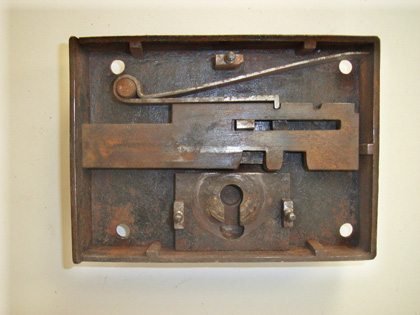 |
| Barron lock. Photo by the author. |
A countryman of Barron, locksmith Joseph Bramah, displayed a lock in the window of his store that he patented in 1784, which was primarily based on the Barron lever tumbler lock. Bramah considered the lock unpickable, and offered 200 pounds to anyone who could manage to open it. A mechanical genius, Bramah created many inventions in other fields, such as hydraulics.
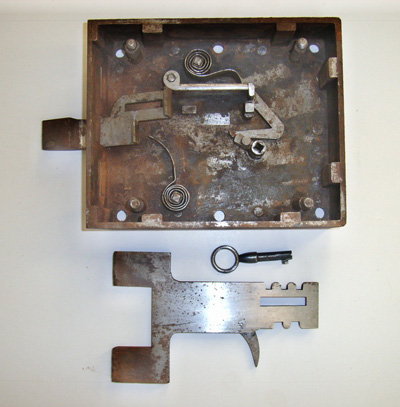 |
| Bramah lock. Photo by the author. |
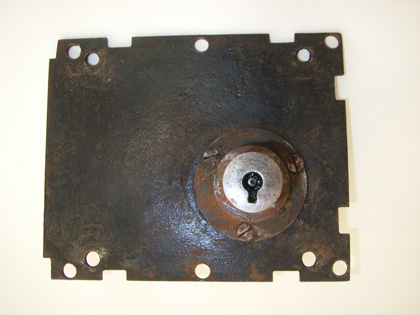 |
| Bramah lock. Photo by the author. |
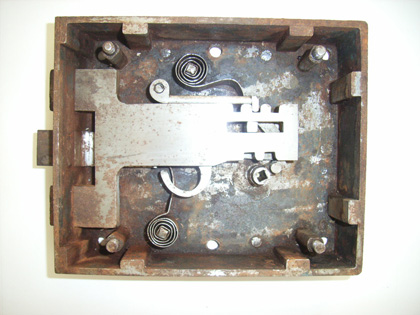 |
| Bramah lock. Photo by the author. |
The detector lock
Jeremiah Chubb of Portsmouth, England, invented a detector lock, a type of lever tumbler that instantly stopped working if the wrong key was used. Only the original key or a special regulator key would activate the lock again. Chubb invented the lock in 1818 in response to a government-sponsored contest to develop an unpickable lock. It remained unpicked until the World Fair in London in 1851.
It all began when a thief used false keys to break into the Houses of Parliament. This prompted the British Government to announce a competition to produce a lock that could only be opened with its own key.
The Chubb lock was based on those of Robert Barron and Joseph Bramah. It had a spring-loaded bolt, which was held in closed position by four oblong perforated brass lever tumblers. The tumblers were placed one on top of the other and locked on one end with a dowel. The other end of the tumblers were lifted by the bit of the key, which was shaped like a sort of staircase, each step corresponding to one of the levers. The bolt could only be shot or drawn once all four tumblers were moved to just the right position.
If an attempt was made to open the lock with a pick or the incorrect key, the lock ceased to work, because one of the levers, moving into the wrong position, was trapped by a regulator. Only the original key, or a special regulator key, could move the levers back to the correct positions.
The result was an unpickable lock, and a £100 reward from the British Government to Chubb.
In 1820, Jeremiah Chubb and his brother Charles started their own lock company, at the same time moving from Portsmouth to Wolverhampton, where all the British lock manufacturers were located.
They made some adjustments to their design, but the principle remained the same. In 1824, Charles patented an improved version that didn’t need a regulator key to reset the lock. The original lock had four lever tumblers, but in 1847 Charles and his son John had increased the number to six. Later they also invented a device that made it impossible for a lock-picker to detect the additional tumblers.
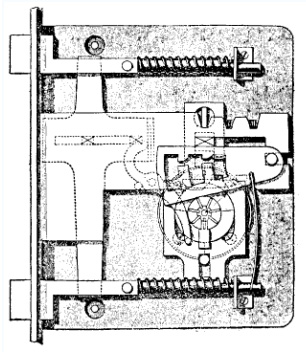 |
| The combined Bramah–Chubb lock |
Charles’s youngest son John was hired by the company, and on his father’s death in 1846 became its sole owner. When he passed away thirty years later, his three sons took over. In the early 20th century, the Chubb company moved its safe manufacturing division from London back to Wolverhampton. In 1956 Chubb & Sons took over another well-known lock and safe manufacturer, Hobbs Hart & Co Ltd., and a few years later the Milner safe company in Liverpool. In 1984, Chubb & Sons Lock & Safe Co Ltd became a part of the Racal Electronics group, making the Chubb lock group one of the largest in its field in the world. Another company, Williams Holdings, bought Chubb Security in 1997, but sold it on to ASSA-ABLOY in 2000 after poor sales figures.
The protector lock
Another locksmith, American Alfred Charles Hobbs, invented the protector lock. Hobbs became famous as the first man to be able to pick the “unpickable” Chubb detector lock at the 1851 World Fair in London (the Great Exhibition). Using an instrument he had developed himself, he was able to maneuver the levers into position to disengage the bolt without damaging the lock, in just 25 minutes. He also managed to pick Joseph Bramah’s patented lever tumbler lock, 41 years after Bramah’s death. It took Hobbs 16 days and got him only glory, as the £200 reward offer had expired when Bramah died.
 |
| Double-bitted key to German Theodor Kromer’s lever tumbler lock. |
Reliable safe locks were not the sole domain of the United States and Britain. An Italian named Tossi patented a lever tumbler lock like Chubb’s at about the same time. But the most successful locksmith was German Theodor Kromer, who patented a protector lock in 1874. The lock was designed for industrial production and easily drove the more expensive, largely hand-made British Bramah locks out of the market. Kromer’s protector lock was basically a tumbler lock. Unlike the Bramah locks, the eleven tumblers were grouped around a turnable cylinder placed inside another cylinder. A double-bitted key with eleven notches on each bit manipulated the tumblers. This means that the lock had a total of 87 million variations. The inner cylinder could only be turned once all the tumblers were in the right position.
Combination or Dial lock. A four-sided lock design featuring a flat round dial with numbers on it. A spindle connects it to a flat wheel or a moving disc tumbler. When the dial is turned, it moves the disc tumbler and rotates a second wheel, which in turn rotates a third, etc. Each of the tumblers has a small notch, just big enough to hold an obstruction. When all three or four notches line up, the obstruction drops into a hole and maneuvers the bolt.
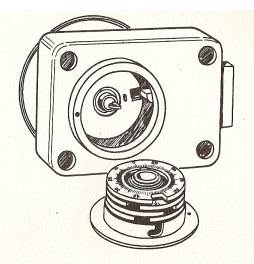 |
| Combination lock with numbers. |
A time lock is controlled by a clock that is independent of a combination or keys. Usually there are three serial clocks, each of which can individually control the lock. The idea is to eliminate the need for repairs and to ensure a backup if one of the clocks stops for some reason.
A multiple custody system means that three or four people must be involved in opening the lock. All of them must be present at every opening, and each of them is only aware of his or her part of the combination.
Locks for safe-deposit boxes differ from other locks in two ways. First of all, they require two separate, different keys to open them – one for the bank employee and one for the customer. Second of all, the keys must be turned at the same time.
Timbination locks are combination locks that use dual time settings to delay the opening of the lock from five to 30 minutes. They were intended to protect against daylight bank robberies or armed robberies.
Picking locks
Different types of locks require their own picking techniques. Lockpicking has become a hobby for many. Picks are cleverly designed tools. It is not illegal to pick locks in Sweden, as long as they are your own locks. However, in public places only trained locksmiths on duty are allowed to carry picks.
The first time lock picks and unpickable locks are mentioned in connection with Swedish locks is in the marketing of Christoffer Polhem’s padlocks, called Polhem or Scandinavian locks. In the early 18th century, he wrote of his own locks that:
"Work at the factory also ceased, despite that there was great need and use for this lock when all ordinary locks were inferior to it. My invention was so safe that I was willing to wager anyone a thousand ducats that no one, in any way whatsoever, can pick or use a skeleton key on the locks that I have made, and that cost no more than ordinary locks."
Another method of breaking into locks is to use an X-ray machine to look at the internal workings and arrive at the combination – but modern materials can make X-raying impossible.
Peeling means removing the protective outer layer of the lock on a vault.
Locksmith certification
Many authorities have set up specific requirements for all those who work in the security industry. The police and fire administrations, insurance companies, manufacturers and industry organizations, housing authorities and rescue agencies are some of them. Their experts formulate the requirements in the form of norms. In Sweden, the Swedish Theft Prevention Association and the Swedish Fire Protection Association are in charge of publishing the official norms.
SBSC is the company in Sweden that issues locksmith certification according to the official published norms. The company also serves as a referral body when the norms are updated.
Break-ins on film
The film industry loves its safecrackers. The intense excitement created in the scene makes the audience oblivious to the fact that the actual picking of the locks is far too easy to be realistic.
One of the most famous European movies on this theme is the 1955 French film “Rififi” (Du rififi ches les homes), directed by Jules Dassin. Many films show thieves breaking into safes and vaults using sensitive fingertips and a stethoscope to find the right code in a rotating combination lock. (Although after 1960, all new combination locks were soundless.) Another common scene is the burglars blasting their way into a vault with explosives.
Among famous movies with safecracking scenes are You Only Live Twice (1967), On Her Majesty’s Secret Service (1969), Thunderbolt and Lightfoot (1974), Thief (1981), Vabank (1981), Short Circuit 2 (1988), Die Hard (1988), Hudson Hawk (1991), Killing Zoe (1994), Heat (1995), Safe Men (1998), Blue Streak (1999), Ocean’s Eleven (2001), The Score (2001), The Italian Job (2003), Bad Santa (2003), Brainiac (2003), and The Ladykillers (2004).
References
Chrichton, Whitcomb. Practical Course In Modern Locksmithing. Nelson-Hall Co. Chicago 1943.
Chubb & Sons Lock & Safe Co Ltd. Lock Making, Wolverhampton City Council. 2005.
Dempsey, Jock. Lockpicking for Lockmakers. Old Locks. 2002.
History of Locks. Encyclopaedia of Locks and Builders Hardware. Chubb Locks. 1958.
Monk, Eric. Keys. Their history & collection. Britain 1983.
Roper, C.A. & Phillips, Bill, The Complete Book of Locks and Locksmithing. McGraw-Hill. 2001.
Rosengren, E A Kassaskåpsfabrik, Göteborg. Referenser. Göteborg 1907.
Swahn, Jan-Öjvind and EA Rosengrens AB, Göteborg. Bevare mig väl. Uddevalla 1989.